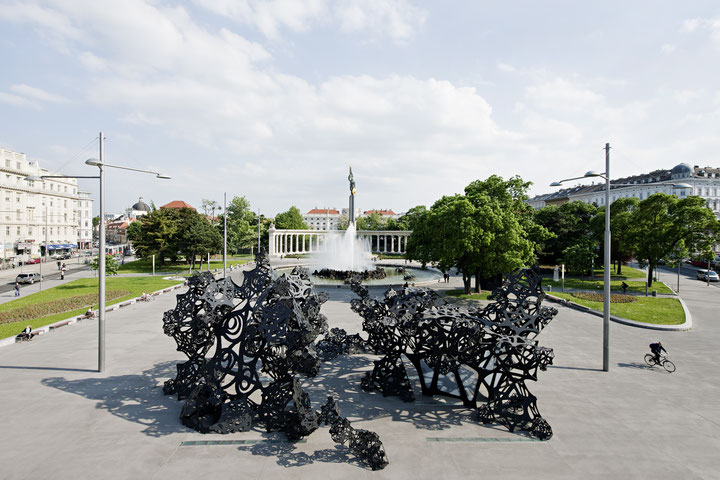Issue 4/2011 - Net section
Architectural/Auditory Attraction
The Project »The Morning Line« Stops Over in Vienna
In June 2011, three radical open-air concert nights launched what is currently one of the most remarkable sound interventions in Vienna’s public space. After Seville and Istanbul, Vienna was the third stop for the migrating sound architecture »The Morning Line.« Placed in an urban space, as emblematic as a fractal cyborg, the system with its 47 individually triggered loudspeakers offered a unique opportunity for spatial listening.
The project, developed by the Thyssen-Bornemisza Art Contemporary Foundation (T-B A21), was installed on a corner of Schwarzenberg square. The urban stage is dominated here by both the equestrian monument to Napoleon’s opponent Field Marshal Schwarzenberg on one side and the Hochstrahlbrunnen fountain right across from it with its Red Army Monument commemorating the Soviet soldiers who died in the fight against the Nazis. At first it seemed risky to recode this traffic hub – complete with quiet zones mainly frequented by tourists – for advanced electronic music. But stars of the musical avant-garde had flocked here for the opening: Yasunao Tone from Tokyo, previously active in the 1960s in connection with Fluxus; sound architect Finnbogi Pétursson from Reykjavik; and from Kiev, young electronic sound artist Kateryna Zavoloka, whose recordings of sounds in nature and sampled Ukrainian folk music contrasted with German techno artist Carsten Nicolai’s abstract tone series. It was interesting to see that such compositions have to be relegated neither to secluded academic circles nor to dark clubs. The live program, curated by Franz Pomassl, functioned as an effective public initiation for the main act that subsequently began continuous operation.
That act was »Morning Line« itself, with its open, pavilion-style architecture: a sound machine that can be fed with all types of spatially conceived compositions. Based on drawings by New York artist Matthew Ritchie, the installation was designed by Aranda\\\\Lasch & Arup AGU. For more than five months, the sound system that was integrated into the architecture by sound engineer Tony Myatt will play 30 compositions entered into a database, each created in one of the different cities.
Clearly, several perspectives on 20th-century avant-garde music come together here. Reflected in the work are not only the ideas of John Cage, who set all manner of everyday sounds on an equal footing with composed music, but also the potential of the electronic generation and deformation of sounds. At the very latest since it became clear that sounds could be generated, modified and interconnected with the help of sine wave generators, following the demiurgic principle and starting with an arbitrary point zero, the logical consequence was to expand the representation of sound as a spatial experience. Hundreds of thousands of visitors enjoyed that very experience at the EXPO 1958 in Brussels when they were subjected to sound emitted by more than 300 loudspeakers at Edgard Varèse’s Philips Pavilion.
»The Morning Line,« however, regards itself as the inversion of the pavilion principle. What is special about this sound architecture, and what most likely is one of its secrets of success, seems to be that all theoretical ballast could just as well be thrown over board. »The Morning Line« simply functions as a visual attraction and – for people nearby – as a sound-producing magnetic field that clearly involves the audience in its acoustic context. As if hypnotized, the ear appears to follow a different dimension of space and time. It is not always possible to pinpoint the origin of the consolidated particles of sound. Sometimes, you wander around, following apparently rambling, mutating sounds. And at other times, you slip into a four-dimensional rhizomorphic geometry of sound squadrons. This phenomenon visibly animates the audience to actively follow the vibrating accumulations of noise.
Some listeners wander about, others turn around astounded as the realization slowly dawns on them of the impossibility of grasping in their entirety the sound events they are witnessing. Sounds here are different from sounds there. Topographically, the electronic effects seem to take on a life of their own, no matter whether it’s a recorded and spatially replicated bass clarinet solo by Evan Ziporyn or the mathematically constructed work »No Rest Even For The Static (Matter II)« by C. M. von Hausswolff. The latter is based on 24 tracks of gradated sequences of metallic-sounding tones that are distributed via acoustic coordinates as if across a finely calibrated three-dimensional net. Mediation and support are organized here with the same sensitivity the musicians exercised when entering their works into the sound architecture’s database. Information about the individual sound compositions is available on a screen or in brochures handed out in a booth manned all day long – one of the many signs of the care that went into this project. After all, »The Morning Line« has pushed the idea of the spatial presentation of sound to the limits. As an urban intervention, it also has a connection with the field of public art.
»The Morning Line« is installed on Vienna’s Schwarzenberg square through November 20, 2011. www.tba21.org/pavilions/103?category=pavilions
Translated by Jennifer Taylor-Gaida


